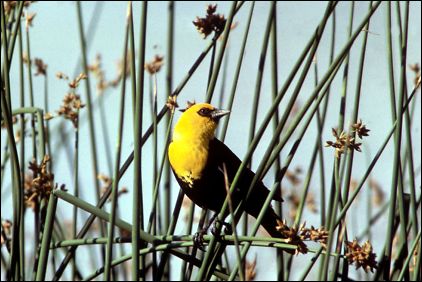
When biologists makeup a common name for a diverse group, the end result often is ludicrous. Look at the Icteridae, for example. Some common members are black, so the name given to the family, blackbirds, seems to make some sense. Sense, that is, right up to the time you realize who's really included in the family.
Now meadowlarks aren't the most brightly colored birds in the
world, but they sure aren't black! Then there's the Yellow-headed Blackbird.
True, much of the body is black, but a bright yellow head and breast don't bring to
mind a "blackbird". If you still need convincing, there are always the
orioles: yellow or orange and white markings barely accented with black. Even black
blackbirds aren't always black—not unless you count iridescence as black.
Take the Great-tailed Grackle, a common bird in parts of the Chihuahuan Desert.
Admittedly, the brownish female is rather drab. But every twist and turn of a
supposedly black male as it displays for its prospective mate provides a new
combination of purples, blues, and greens. Black? Not hardly! 
Contributor: Arthur H. Harris, Laboratory for Environmental Biology, Centennial Museum, University of Texas at El Paso.
Desert Diary is a joint production of the Centennial Museum and KTEP National Public Radio at the University of Texas at El Paso.

Yellow-headed Blackbird (Xanthocephalus xanthocephalus) amidst sedges, Bear River National Wildlife Refuge, Utah. Photograph by James C. Leopold.
Sibley, D. A. 2000. The Sibley guide to birds. Alfred A. Knopf, New York. 544 pp.
University of Michigan Museum of Zoology. Photographs, sounds.